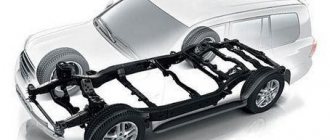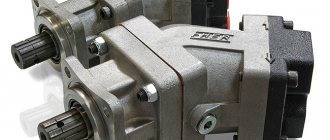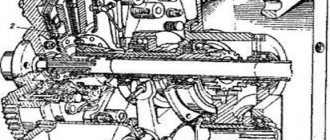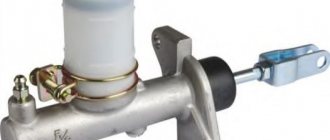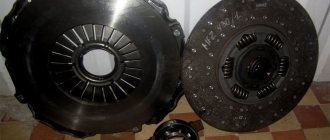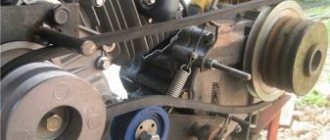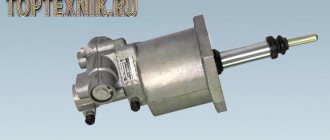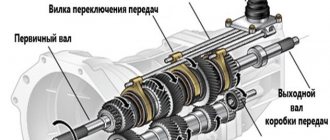The clutch is a mechanism designed to transmit engine torque to the gearbox, as well as smoothly connect and disconnect the engine with the transmission mechanisms. With its help, you can start driving a car, change gears, stop with the engine running, and maneuver during sudden changes in speed.
The clutch mechanism protects the vehicle's engine and transmission parts from damage and overload during rapid gear changes and sudden braking.
At the end of this article, watch the video tutorial , which very clearly demonstrates how the clutch mechanism in a car works.
And below we will talk about the principle of operation of the car clutch, the design and types of drives for engaging and disengaging the clutch, and how to properly use the clutch mechanism on cars with a manual transmission.
Car clutch device
The operation of the car’s clutch is ensured by the following parts:
- flywheel;
- fork;
- pressure disk;
- spring (can be push or pull type);
- release bearing and clutch;
- driven disk;
- drive elements.
The flywheel is responsible for transmitting torque to the gearbox. It is mounted on the crankshaft of the engine. The pressure plate, or as it is also called the “basket,” is an element rigidly fixed on the flywheel, to which the springs of the driven disk are attached.
The pressure and driven disks in connection with the flywheel are responsible for the smooth distribution of torque from the engine to the manual transmission. The parts are in close contact with each other or move away from each other, depending on the pedal press inside the car.
The push clutch performs the main function: it smoothly disconnects during braking and connects the engine and gearbox when starting. At the same time, it compensates for the load and minimizes the vibration impact from the engine, thereby partially unloading the elements of the engine, vehicle transmission and clutch unit.
The release bearing protects the clutch from wear. When you press the pedal, the fork separates the pressure and driven discs. The remaining components of the clutch drive are cables, hydraulic cylinders, tubes and the pedal itself.
Basic clutch malfunctions
The clutch “leads” (does not disengage completely) due to large free play of the clutch pedal, skewed pressure bearing, warped driven disk or broken springs. To eliminate the malfunction, adjust the free play of the pedal, remove air from the hydraulic drive, and replace inoperative disks and springs.
The clutch “slips” (does not engage fully) due to small free play of the pedal, oiling or wear of the friction linings of the driven disk, or broken springs. To eliminate the malfunction, it is necessary to adjust the free play of the pedal, wash or change the discs and springs.
The clutch engages abruptly due to jamming in the drive mechanism, scuffing on the working surfaces of the disks, flywheel, and destruction of the friction linings of the driven disk. To eliminate the malfunction, it is necessary to replace the faulty drive components, eliminate scuffs on the surfaces of the disks, and replace the driven disk.
Leakage of brake fluid in the clutch release drive is possible from the main or working cylinders, as well as in the connecting pipes. To eliminate the malfunction, you should visually determine the location of the leak and replace the faulty components, followed by bleeding the entire hydraulic drive (remove air from it).
What happens when you press the pedal
It is physically impossible to change speed with constant engine pressure on the gearbox. The clutch was invented in order to smooth out vibrations. It absorbs impacts during the transition from gear to gear, protecting the car from overloads.
The switching process is as follows:
- the driver from inside the car presses the clutch pedal with his left foot;
- the fork moves the release bearing;
- the release bearing secures the blades of the diaphragm spring;
- the compressed spring stops pressing on the pressure plate;
- the engine is disconnected from the transmission;
- the driver releases the clutch pedal;
- the fork does not affect the release bearing and spring;
- the pressure plate presses the driven disk against the flywheel;
- The transmission is reconnected to the engine.
General information [ edit | edit code]
There are many different types of clutch, but most rely on one or more friction discs pressed tightly together or onto the flywheel by springs. The friction material is very similar to that used in brake pads and previously almost always contained asbestos; more recently, non-asbestos materials have been used. Smooth engagement and disengagement of the gear is ensured by the sliding of the constantly rotating drive disk attached to the engine crankshaft relative to the driven disk connected through a spline to the gearbox.
How to understand that the clutch is breaking
There are “bad habits” that lead to rapid wear of the car’s mechanical clutch. You should try to avoid them in order to prolong the life of the parts. Will lead to a quick repair:
- Intensive pressing of the gas pedal when starting the car. The higher the engine speed when the clutch is depressed, the more the discs wear out.
- Keeping the clutch pedal depressed during short stops, for example, at a traffic light. Excessive pressure exhausts the life of the release bearing and pressure spring. In such situations, it is better to switch to neutral gear.
- The habit of forgetting to release the pedal and driving like this for some distance. Novice drivers can get confused with their feet and pedals when driving with the clutch depressed. Instructor tips and driving practice will help you avoid this mistake.
- Keeping your foot not on the side, but on the clutch pedal, while the car is moving. Even if you seem to be in control and are not pressing the pedal, the driven disc will not be pressed tightly enough against the flywheel. This will lead to its premature erasure.
To avoid having to constantly change parts, you need to immediately learn how to change gears correctly and smoothly press and release the pedals. But after some time, a loaded system will still wear out. If the gears begin to change poorly or the car starts to move only when the clutch pedal is completely released, this is a reason to sign up for an auto repair shop.
In addition, the following may indicate a breakdown:
- strong vibration when pressing the pedal;
- grinding, crackling noise when changing gears;
- jerks when starting from a standstill even with the clutch released smoothly;
- uncharacteristic whistle, hum, squeal when squeezing the pedal;
- slipping, accompanied by a burning smell;
- difficult pressing or jamming - the lever is squeezed all the way, but does not return to its original position.
Classification [edit | edit code ]
- According to the control method - clutches with a mechanical, hydraulic, electric or combined drive (for example, hydromechanical).
- By type of friction - dry (friction linings work in air) and wet (work in an oil bath).
- According to the switching mode - permanently closed and non-permanently closed.
- According to the number of slave disks - single-, double- and multi-disk.
- According to the type and arrangement of pressure springs - with the arrangement of several cylindrical springs along the periphery of the pressure disk and with a central diaphragm spring.
- According to the number of torque transmission streams - single and double stream.
Tips for beginners
To avoid burning out the clutch when starting and changing gears, use the basic recommendations from the Akademika driving school.
Algorithm for moving away with a manual transmission:
- start the engine;
- press the brake and clutch pedals all the way;
- move the handbrake to the down position;
- put the lever in first gear;
- smoothly release the clutch pedal while keeping your right foot on the brake;
- press on the gas little by little, releasing the brake.
To change gear correctly, first depress the clutch all the way. Shift to the desired speed by moving the lever and slowly release the pedal until the engine changes RPM. Add some gas and release the clutch completely.
The main thing is, don’t be afraid, do everything smoothly and consistently. If that doesn't work and the car stalls, turn on the hazard lights. Calm down and start over. It is important to learn how to start and change gears correctly, so that you can reinforce this habit later. Only daily practice and self-confidence will help with this!
Two-axle trailer or single-axle trailer: which one to choose, what is the advantage
In short, the clutch connects the engine of your car, be it a VAZ 2110, Priora or some Honda, for example, to the gearbox. At its core, it is the connecting link between the engine and gearbox. But more precisely, the car’s clutch system is designed for a smooth connection between the engine flywheel and the gearbox pulley at moments when a transition is made from one speed to another and the car gradually, and maybe quickly, moves away.
In a literal sense, we are talking about turning off the torque. Plus SS protects the car from overloads and damage to the gearbox during emergency braking.
Now it’s worth going through the clutch components in more detail, and also talking about the varieties.
Ceramic and sintered clutch
Ceramic and metal-ceramic clutches are designed specifically for extreme driving enthusiasts. If you install ceramics on a powerful engine, you can start with a slip and drive so that the rubber will be burned. The cermet clutch also withstands serious loads.
Discs for them are made from raw materials with the addition of carbon fiber. The lifespan of such disks is 5 times longer than regular ones. They cope with mechanical and temperature loads.
Brief historical background
While working on the creation of the first cars, engineers discovered the need for a device that would transmit torque from the engine to the wheels, but with different amplitudes of rotation, so that the car would move smoothly.
Without such a device, every time you wanted to slow down or increase the speed, you would have to completely turn off the engine. And this device was invented by the German engineer Karl Benz in 1885. The clutch then consisted of two pulleys connected by a leather belt. The driver moved the pulleys apart with a lever, which made it possible to open and close the clutch. The next stage in improving the device was the invention of the cone clutch by German engineers Gottlieb Daimler and Wilhelm Maybach in 1889. In the cone clutch design, the leather belt is replaced by a spring. This design was replaced by another - a multi-disc one, which worked in a liquid medium (kerosene or oil). Then Ferodo linings began to be put on the discs, and the automotive industry switched to dry single-plate clutches. The prototype of the modern diaphragm clutch was developed by auto mechanics of the American corporation General Motors in 1936, but due to the war, their mass production began only in 1965 and continues today.
Dry double-disc clutch
The most popular is dry two-disc SA. It is mounted on boxes with an odd number of gears.
Most of the parts in this unit are paired. Two pressure plates, two diaphragm springs, two bearings, two switch levers.
Even with the small size of the mechanism, thanks to this design feature, impressive torque can be obtained. Positions itself as a solution that can increase the smoothness of gear shifting and driving comfort.
With this SA, even a car with a manual transmission can easily reach high speeds. Therefore, when most sports cars had a manual transmission, they were equipped with a two-disc SA.
Failure diagnostics
The specificity of the system is the fact that on many cars there is no possibility of computer diagnostics. It is really difficult to equip the disks with additional sensors, which can indicate a high degree of wear of individual mechanisms or their failure. Therefore, the main methods of control are still sound and dynamic examination of devices, secondary signs in the form of changes in pedal travel, vehicle throttle response, and the presence of extraneous mechanical changes.
The clutch is a complex mechanism in a car. When the first signs of a malfunction appear, you should immediately begin to fix the problem. Delay may result in costly engine and transmission repairs.
Did you like the article? Share on social media networks:
Wet Clutch Systems (WMS)
Characteristic features of SMC:
- SMCs operate on motor oil.
- Due to lubrication, there is less wear on the SA.
- Engine oil quickly becomes contaminated (the resulting dust remains in the engine).
- The design provides excellent cooling, facilitating efficient transfer of CM.
Experts note the high service life of the clutch and gearbox (when using high-quality lubricants and replacing them in a timely manner).
SMCs have proven themselves well in vehicle transmissions with torques above 250 Nm.
Dual mass flywheel clutch
Dual-mass flywheel CA is a 2-disc design.
The connector is a spring-damper system. The design includes two blocks (cases). On one there is a starter ring, on the second there is a SA unit. The design is designed so that axial rotation of one body relative to the other is possible.
Advantages:
- The springs work in steps. The first stage is with soft springs, this is important for stable operation of the system when starting and shutting down the internal combustion engine, the second stage is with hard springs. They are used in normal driving mode;
- Minimized noise level in the “ICE – gearbox” unit;
- Increased fuel efficiency (reduced costs for gasoline, diesel);
- Complexity of assembly, entailing a high price.
conclusions
So, in this article we introduced you to the principle of operation of the clutch and explained what functions it performs in the design of the car.
Like any part, the clutch tends to wear out. It is impossible to determine the exact shelf life of this mechanism, since it directly depends on the dexterity and accuracy of the driver. Grip also suffers from uneven road surfaces with deep holes and from traffic jams, since the driver often has to slow down, or even brake completely, and then move off again. Therefore, if you hear an unpleasant smell in the cabin, there is a reason to stop by the service station and have a technical inspection. If you notice an error, inaccuracy or want to supplement the material, write about it in the comments and we will correct the article!
Key tags: car device
